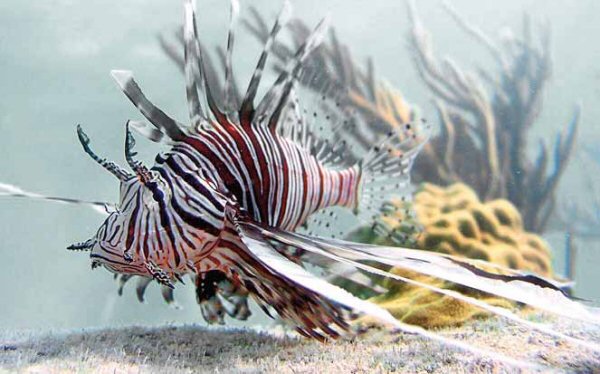SEJournal Online is the digital news magazine of the Society of Environmental Journalists. Learn more about SEJournal Online, including submission, subscription and advertising information.
Science Survey
By RAE TYSON
 |
|
The invasion of predatory lionfish in the Caribbean region poses yet another major threat there to coral reef ecosystems. © Photo courtesy Oregon State University.
|
Arguably, the gypsy moth and kudzu vine are among the nation's most notorious invasive species. But it was the 1988 introduction of the zebra mussel into the Great Lakes ecosystem that heightened the vulnerability of United States' waterways.
Now, a relatively new invader — the Indo-Pacific lionfish — has raised scientific concerns about the vulnerability of the nation's oceans.
"Lionfish could alter the structure of native reef fish communities," said the National Oceanic and Atmospheric Administration (NOAA). "Additional effects of the lionfish invasion are far-reaching and could increase coral reef ecosystem stress, threaten human health, and ultimately impact the marine aquarium industry. " The lionfish belongs to the venomous scorpionfish family and is native to the tropical Indian Ocean and western and central Pacific. Because of their spiny, colorful appearance, they have long been a home aquarium favorite. But, because of their toxic spines, lionfish predictably have few natural predators in a non-native environment.
Scientists aren't sure exactly when they were introduced to U.S. waterways. Popular myth has it that the lionfish was introduced to the south Atlantic in 1992 when Hurricane Andrew unleashed its fury on the Florida coast. Speculation is that the contents of a home aquarium ended up in the waters of Biscayne Bay, which is adjacent to Miami. But divers first documented the presence of the venomous species off Dania, Fla., just north of Miami, in October 1985, some seven years earlier.
Now, the prolific species, its eggs carried by fast-moving currents, has been spotted as far north as Rhode Island and as far south as the Caribbean Sea. Lionfish aren't expected to migrate further north because they have a penchant for warmer waters.
Lionfish reach sexual maturity within two years and reproduce multiple times during the spawning season, according to NOAA researchers. Up to 30,000 eggs can be produced with each spawn.
Scientists predict that the lionfish will soon make its way into the Gulf of Mexico. In June of 2010, a local fisherman caught a lionfish in his net off the coast of the island of Saint Kitts in the Caribbean.
The voracious lionfish has become the leading worry for those who are trying to protect coral-dwelling aquatic species. NOAA found that lionfish are consuming the majority of forage fish available on some reefs, thus crowding out native specimens.
"Consider this as biological warfare on the fisheries of the Virgin Islands," said Shannon Gore, marine biologist with the Virgin Islands Conservation and Fisheries Department.
Adult lionfish have big appetites. They chomp down more than 40 fish species along with crustaceans such as shrimp, crabs and mollusks.
"We are looking at a gluttonous feeder that is eating almost everything that fits in its mouth, including ecologically, economically and recreationally important marine species," Laddie Akins of Florida's Reef Environmental Education Foundation tells SEJournal. The impact of lionfish on some species — notably grouper and snapper — is already significant, scientists say.
To control the spread of this invasive species, NOAA has recommended a three-pronged approach, including population control, outreach and education, and research.
"We are currently considering early detection and rapid response efforts to keep lionfish out of the sanctuaries," said ecologist James Morris, NOAA National Centers for Coastal Ocean Science. "It is unclear at this time if these attempts will be successful."
Some areas are independently taking steps to limit the growth of the invader. In the Bahamas and Florida, several communities are holding annual lionfish derbies. In Florida, divers are asked to capture the lionfish and are provided instructions on how to catch the fish without gouging themselves on the venomous spines.
Well-known Washington, D.C., chef Barton Seaver has another idea — eating them. Recently, he served a meal of lionfish at an event designed to call attention to overfishing in the Atlantic.
"Snacking on red lionfish might help the coral ecosystems along the southern Atlantic coast, where the invasive species (with no known predator) has been wreaking havoc with fish and humans alike," said a Washington City Paper food blog.
Said Akins: "This is about as green as you can get as far as a fish to eat."
All told, over 60 invasive species have been identified in the southern Atlantic and Caribbean oceans. But the prolific lionfish has the potential to have the most significant impact on ecosystems throughout the region.
"The future expansion of lionfish into the coastal waters of the southern Caribbean, Gulf of Mexico, and eastern South America is probable and troublesome," NOAA predicts.
Rae Tyson is a veteran journalist and co-founder of SEJ. Currently on the staff of Environmental Health News, Tyson lives in an old farmhouse near Gettysburg, Pa., which, incidentally, is a long way from the nearest lionfish infestation.
Bibliography:
- December 2009: NOAA's National Ocean Service: "Biology, Ecology, Control and Management of the Invasive Indo-Pacific Lionfish: An Updated Integrated Assessment"
- September 2008: "Invasive Indo-Pacific lionfish Pterois volitans Reduce Recruitment of Atlantic Coral-reef Fishes"; Department of Zoology, Oregon State University.
Sources:
- NOAA National Centers for Coastal Ocean Science lionfish webpage
- U.S. Geological Survey Invasive Species Fact Sheet
- NOAA National Ocean Service lionfish educational website
- Reef Environmental Education Foundastion
Contacts:
- Laddie Akins, director of operations; REEF; Key Largo, Fla. (305) 852-0030
- James A. Morris, ecologist, Center for Coastal Fisheries and Habitat Research, NOAA, Beuford, N.C.,(252) 728-8782
* From the quarterly newsletter SEJournal, Fall 2010 issue.












 Advertisement
Advertisement 



